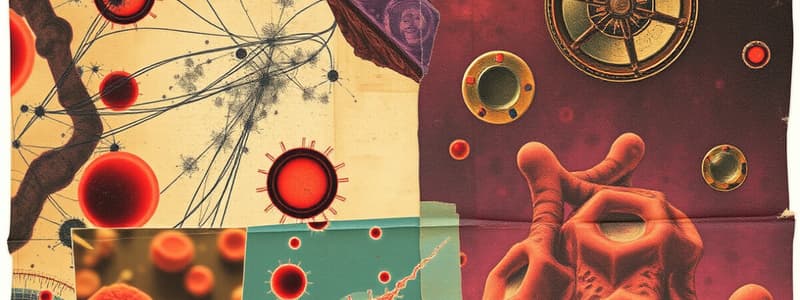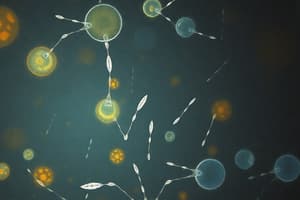Podcast
Questions and Answers
Plasma membranes are a feature of:
Plasma membranes are a feature of:
- All cells (correct)
- Animal cells only
- Eukaryotic cells only
- Plant cells only
- Prokaryotic cells only
Which of the following is NOT a component of plasma membranes?
Which of the following is NOT a component of plasma membranes?
- Glycolipids
- Glycosylated proteins
- Glycosylated nucleic acids (correct)
- Cholesterol
- Phospholipids
Which of the following is NOT true of the plasma membrane?
Which of the following is NOT true of the plasma membrane?
- It is composed of an extracellular and intracellular layer of phospholipids.
- Integral proteins span through the membrane.
- The membrane contains peripheral proteins.
- The membrane contains glycolipids and glycoproteins.
- The extracellular and intracellular layers or leaflets are highly symmetrical. (correct)
N-linked glycosylation is the attachment of a carbohydrate to a nitrogen atom, while O-linked glycosylation is the addition of sugars to the oxygen atom of certain side chains.
N-linked glycosylation is the attachment of a carbohydrate to a nitrogen atom, while O-linked glycosylation is the addition of sugars to the oxygen atom of certain side chains.
The process of covalently attaching a carbohydrate to a protein or lipid is called:
The process of covalently attaching a carbohydrate to a protein or lipid is called:
In eukaryotes, where does the synthesis of most lipids primarily occur?
In eukaryotes, where does the synthesis of most lipids primarily occur?
Facilitated diffusion but not passive diffusion requires energy.
Facilitated diffusion but not passive diffusion requires energy.
Exocytosis is the process by which material from inside of the cell is packaged into vesicles and excreted into the extracellular medium.
Exocytosis is the process by which material from inside of the cell is packaged into vesicles and excreted into the extracellular medium.
The following solutes have very low permeability through the plasma membrane:
The following solutes have very low permeability through the plasma membrane:
Water can freely diffuse through animal cell membranes.
Water can freely diffuse through animal cell membranes.
Flashcards are hidden until you start studying
Study Notes
Plasma Membranes
- Plasma membranes are present in all types of cells, including prokaryotic and eukaryotic cells.
- Key components of plasma membranes include phospholipids, cholesterol, glycosylated proteins, and glycolipids.
Composition and Structure
- Glycosylated nucleic acids are NOT a component of plasma membranes.
- The extracellular and intracellular leaflets of the plasma membrane are NOT highly symmetrical, contrasting with a common misconception about their structure.
- Peripheral proteins exist on the membrane surface, while integral proteins are embedded, spanning the membrane.
Glycosylation
- N-linked glycosylation involves attaching carbohydrates to the nitrogen of asparagine residues, while O-linked glycosylation attaches sugars to the oxygen of serine or threonine residues.
- Glycosylation is a process for covalently connecting carbohydrates to proteins or lipids, enhancing their functionality.
Lipid Synthesis
- Most lipid synthesis occurs at the cytosolic leaflet of the smooth endoplasmic reticulum (ER) membrane due to interactions with the endomembrane system and cytosol.
Transport Mechanisms
- Facilitated diffusion does NOT require energy, while passive diffusion also operates without it.
- Exocytosis involves packaging materials within vesicles for secretion from the cell into the extracellular space.
Membrane Permeability
- Charged polar molecules and macromolecules exhibit very low permeability through the plasma membrane, limiting their passive transport.
- Water cannot freely diffuse through animal cell membranes, highlighting the regulated nature of cellular water transport.
Studying That Suits You
Use AI to generate personalized quizzes and flashcards to suit your learning preferences.



